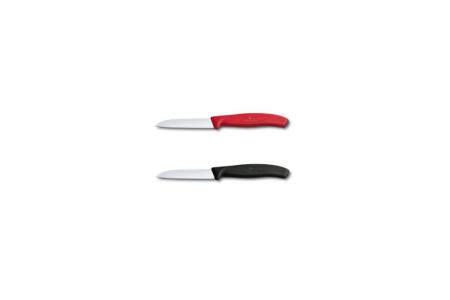The kitchen is a place where creativity meets practicality, and among the array of culinary tools, the paring knife stands out as a vital instrument for both professionals and home cooks. Often underestimated due to its size, the paring knife delivers unmatched precision, control, and versatility. In this article, we will delve into everything you need to know about this small but mighty kitchen tool.
What Is a Paring Knife?
A paring knife is a small knife with a plain edge blade that usually ranges from 2.5 to 4 inches in length. Unlike larger kitchen knives such as the chef’s knife or santoku, the paring knife is specifically designed for intricate tasks that require attention to detail and close control. It’s most often used for peeling, trimming, and slicing small fruits and vegetables, deveining shrimp, and even for precise garnishing work.
Despite its compact size, the paring knife is one of the most functional tools in any kitchen. The shape and balance of a paring knife allow the user to make controlled cuts that are difficult to achieve with larger knives. Whether you’re peeling apples or segmenting citrus fruits, a sharp paring knife can make all the difference.
History and Evolution of the Paring Knife
The paring knife has evolved over centuries, with roots in ancient culinary traditions. Initially made with simple steel blades and wooden handles, paring knives have grown to include a variety of blade shapes and materials. As cooking techniques have developed, so too has the design of the paring knife. Modern innovations have led to stainless steel and ceramic blades, ergonomic handles, and finely honed edges that cater to a cook’s individual preferences.
Over time, the paring knife has become indispensable for chefs in high-end restaurants as well as in household kitchens. Its rise in popularity is due not only to its functionality but also to its adaptability. From classic European styles to sleek Japanese models, the paring knife continues to be reinvented to meet the demands of modern cooking.
Different Types of Paring Knives
While the basic purpose of a paring knife remains the same, there are several types that serve slightly different functions. The most common is the spear point paring knife, which features a straight blade that tapers to a sharp point. This is the most versatile type and can be used for a wide range of tasks.
Another type is the bird’s beak paring knife, with a curved blade ideal for peeling rounded fruits and vegetables. The sheep’s foot paring knife, which has a straight edge and rounded tip, is great for straight cuts without puncturing the skin of softer foods. Each type offers its own unique advantages, and choosing the right paring knife depends on the specific tasks you need to perform.
Benefits of Using a Paring Knife
One of the biggest advantages of a paring knife is its precision. Unlike bulkier kitchen knives, it allows for close-up work with fine detail. Whether you’re coring strawberries or mincing garlic, the paring knife gives you control that is hard to match.
Another benefit is its lightweight nature, which reduces fatigue during prolonged use. Its compact design also makes it easier to maneuver, allowing for faster and more accurate cuts. The paring knife is also extremely versatile, capable of handling many small kitchen tasks without needing to switch tools.
Durability is another plus, especially when you invest in a high-quality paring knife. Stainless steel and high-carbon steel blades maintain their sharpness for extended periods and resist corrosion, making them reliable kitchen companions for years to come.
How to Choose the Right Paring Knife
When selecting a paring knife, consider factors like blade material, handle design, and balance. Stainless steel is a popular choice for its durability and ease of maintenance. High-carbon steel offers sharper edges but requires more care to prevent rust. Ceramic blades are ultra-sharp but more prone to chipping.
The handle should feel comfortable and secure in your hand. Whether made from wood, plastic, or composite materials, the handle should provide a non-slip grip. The balance between the blade and handle is also important, as a well-balanced paring knife reduces hand strain and improves control.
Always test the knife in your hand if possible before purchasing. A good paring knife should feel like a natural extension of your arm, allowing you to work with confidence and ease.
Caring for Your Paring Knife
Proper care ensures that your paring knife stays in top condition. Handwashing is recommended, as dishwashers can dull the blade and damage the handle over time. After each use, rinse the blade with warm water, gently scrub it with a soft sponge, and dry it immediately.
Regular honing will keep the blade sharp. Use a honing steel every few uses, and consider professional sharpening a few times a year if the blade begins to dull. Always store your paring knife safely—either in a knife block, sheath, or on a magnetic strip—to protect both the blade and your fingers.
Avoid using your paring knife on hard surfaces or for tasks it wasn’t designed for, such as cutting bones or hard squash. Using it correctly will extend its lifespan and preserve its cutting efficiency.
Common Mistakes to Avoid
Many home cooks misuse their paring knife by employing it for the wrong tasks. It’s not designed for heavy-duty chopping or slicing large cuts of meat. Doing so can damage the blade and reduce its effectiveness. Another common mistake is neglecting regular maintenance, which leads to dull blades and poor performance.
Holding the knife incorrectly is another issue. Grip the handle firmly, with your index finger and thumb pinching the blade just in front of the handle. This grip offers better control and reduces the risk of slipping.
Finally, avoid storing your paring knife loosely in a drawer. Not only is this dangerous, but it can also damage the blade’s edge. Use proper storage solutions to keep your knife sharp and safe.
Conclusion
The paring knife may be small, but it holds a significant place in the culinary world. Its precision, versatility, and ease of use make it a must-have tool in any kitchen. Whether you’re a professional chef or a home cook, mastering the paring knife will elevate your food preparation to a new level.
From peeling delicate fruits to making intricate garnishes, the paring knife offers unmatched performance in the hands of those who know how to use it. Investing in a high-quality paring knife and learning how to care for it properly will pay off in countless meals prepared with precision and pride.
In the realm of kitchen tools, the paring knife proves that sometimes, the best things really do come in small packages.
- The paring knife may be small, but it holds a significant place in the culinary world.
- The paring knife may be small, but it holds a significant place in the culinary world.
- paring knife
Related posts:
 Easy EMI Card: Your Go-To Solution for Easy Monthly Payments
Easy EMI Card: Your Go-To Solution for Easy Monthly Payments
 Syna World Redefining Modern Fashion & Syna Worldwide More Than a Brand
Syna World Redefining Modern Fashion & Syna Worldwide More Than a Brand
 How the AED to PKR Open Market Rate Affects Pakistani Expats in UAE
How the AED to PKR Open Market Rate Affects Pakistani Expats in UAE
 Top Temperature Data Logger Manufacturers in India – Reliable & Accurate Solutions Powered by Nimbus Technologies
Top Temperature Data Logger Manufacturers in India – Reliable & Accurate Solutions Powered by Nimbus Technologies
 GCC Augmented Reality Market Size, Forecast 2025-2033: A Comprehensive Industry Analysis
GCC Augmented Reality Market Size, Forecast 2025-2033: A Comprehensive Industry Analysis
 Embracing the Call — Supporting Life Through Christian Faith
Embracing the Call — Supporting Life Through Christian Faith
 Make Waves on Your Birthday with SunFunFTL’s Luxury Boat Rentals in Fort Lauderdale
Make Waves on Your Birthday with SunFunFTL’s Luxury Boat Rentals in Fort Lauderdale
 Biodegradable Packaging Trends Across Asia-Pacific & Global Markets
Biodegradable Packaging Trends Across Asia-Pacific & Global Markets







